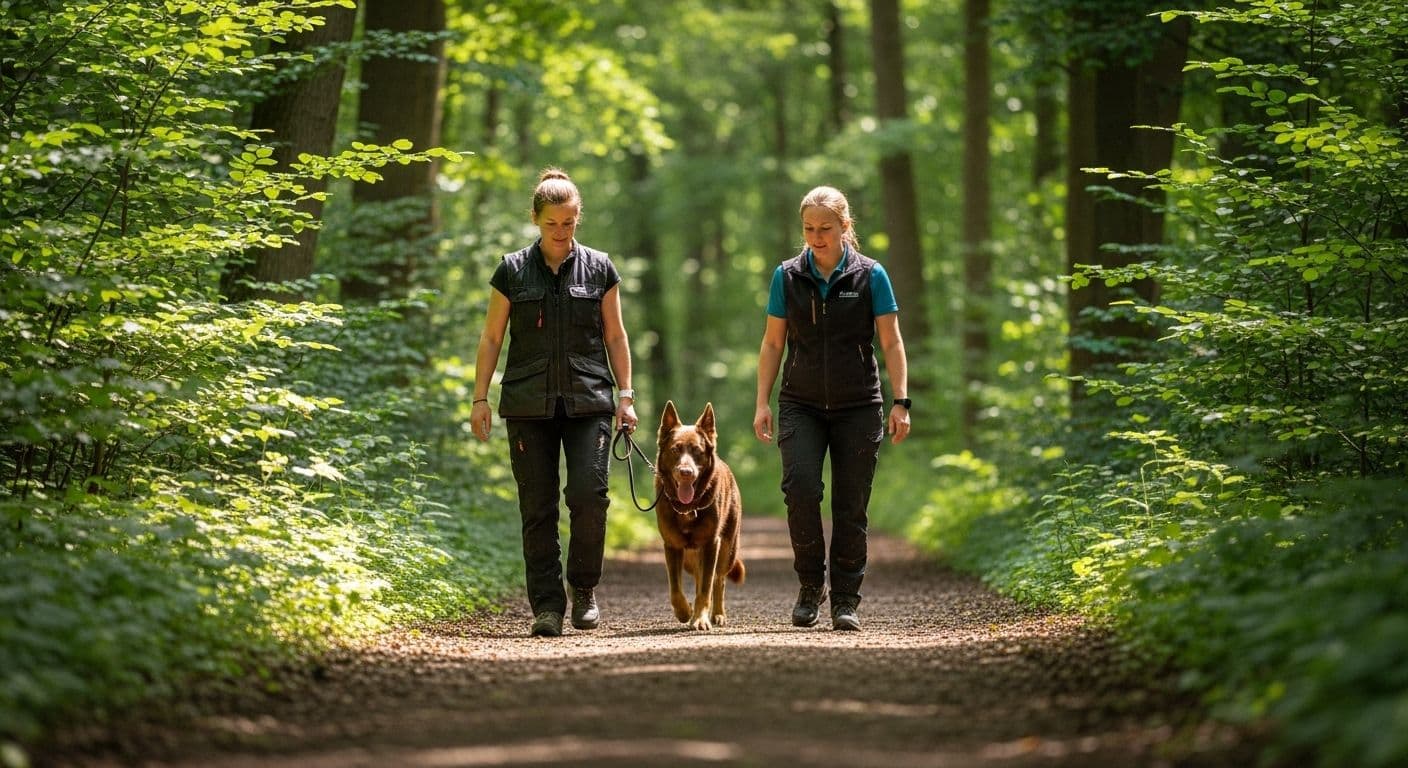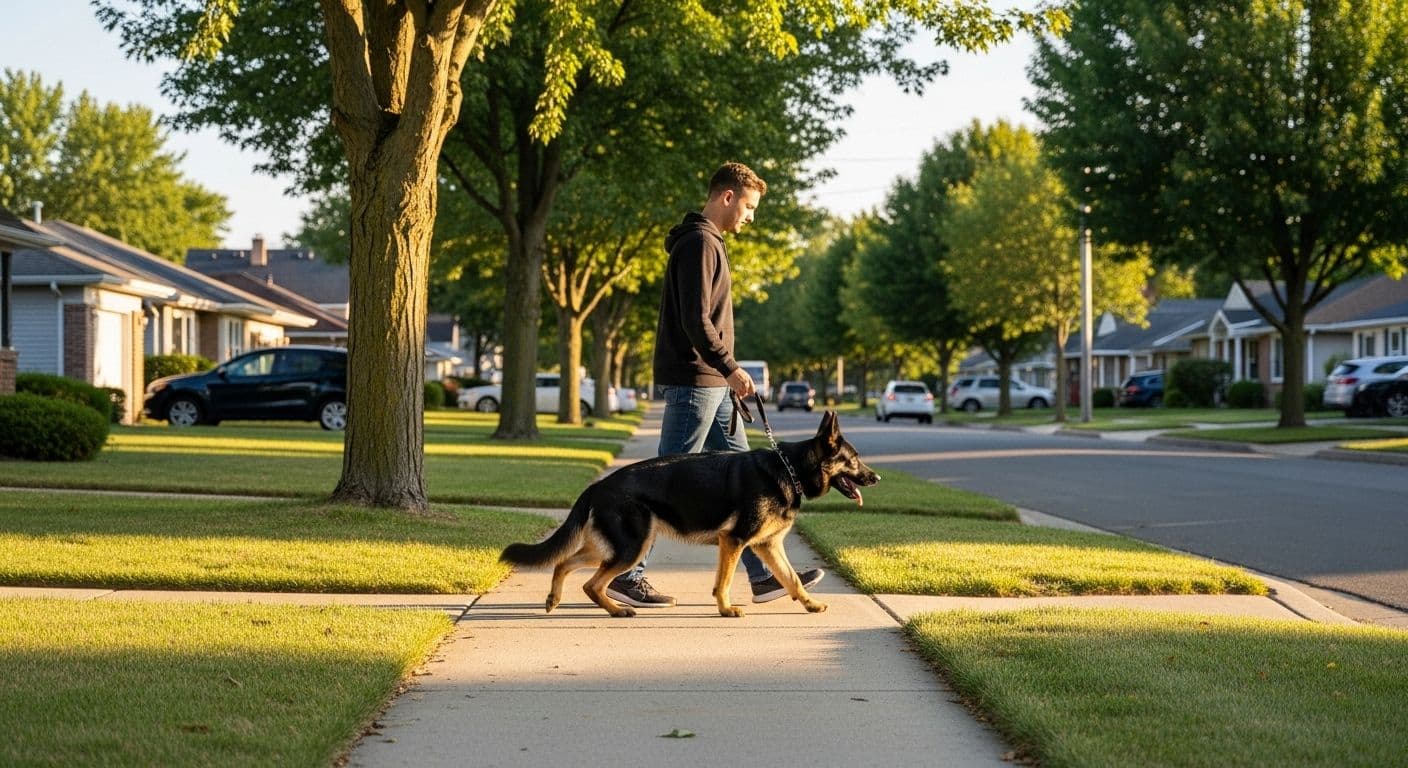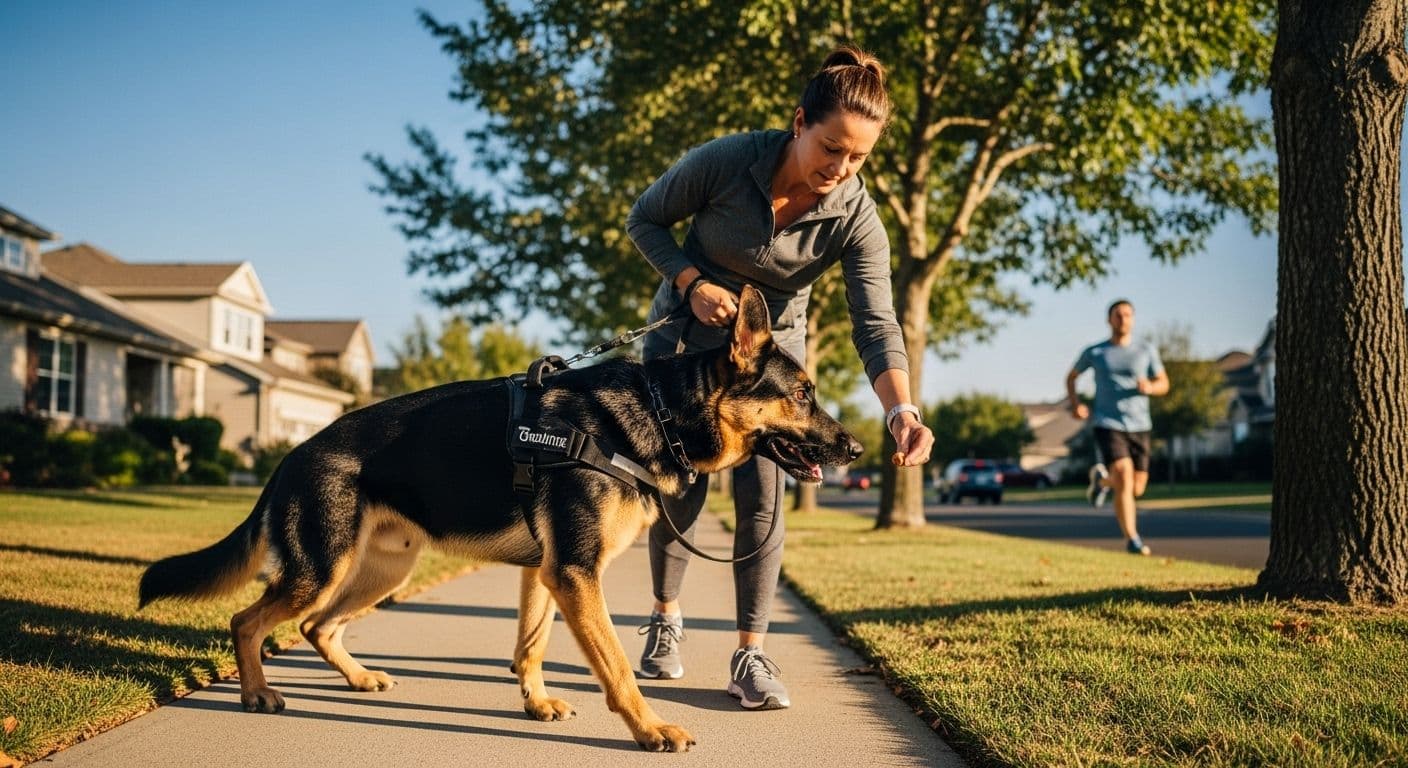Ever found yourself doing the side-eye shuffle with your pup as he drags you past the neighbor’s roses? We’ve all been there. If you’ve been Googling how to teach a dog to heel but feel buried in opinions, relax, help has arrived. In this step-by-step guide you’ll get plain-English answers, zero fluff, and a routine you can start today. By the time you’re done reading, you’ll know exactly what the heel dog command means, which tools you really need, and a daily plan that turns tug-of-war walks into easy, in-sync strolls.
What Does “Heel” Mean?

First things first: what does heel mean for a dog anyway? In simple terms, “heel” tells your dog, “Walk right beside me on a loose leash, match my pace, and keep half an ear on me until I say we’re done.” In formal obedience, that usually means your dog is on your left with his shoulder lined up to your leg and an automatic sit when you stop. At home you can pick either side, left or right is fine, but stick to one so your pup’s never guessing.
Why bother with the heel command at all? Picture this: a biker zooms past, a squirrel darts across the sidewalk, or a city bus screeches by. With a dog at heel, you’ve got an instinctive safety bubble. Plus, heeling nurtures impulse control, burns mental energy, and turns you into the coolest thing on the block (at least in your dog’s eyes). Not bad for a cue that takes just minutes a day to teach, right?
Gear You Need Before You Start
Good news: you don’t need to raid a pet-store aisle to teach dog to heel. A few well-chosen basics will do all the heavy lifting.
- Flat buckle collar or well-fitted harness – Smooth edges, no digging into the shoulders or throat.
- Six-foot lightweight leash – Short enough for quick feedback, long enough to stay slack.
- Treat pouch or roomy pocket – Fishing around for treats breaks momentum; stash them where you can grab fast.
- High-value treats – Think pea-sized bits of chicken, cheese, or commercial soft trainers, whatever makes your dog light up like it’s payday.
- Clicker (optional) – A crisp, consistent marker that says “That! Right there!”
- Quiet indoor space – Hallways, living rooms, kitchens, anywhere you can control distractions.
Notice what’s not on the list: prong collars, head halters, fancy retractable leashes. Those can be helpful later for management, but the real learning comes from timing, consistency, and reinforcement, not hardware.
how to teach a dog to heel Indoors
Ready to roll? Clear 15 distraction-free minutes, phone on silent, coffee handy and follow this progression. Short, sweet, and to the point.
- Name & Invitation
Say your dog’s name once. The second he looks your way, lure him to your chosen side with a treat pinched between thumb and forefinger. - Mark the Position
The instant his shoulder lines up with your leg, click or say “Yes!” and feed right by your hip. Feeding in position keeps him from crossing in front. - Three-Step Drill
Take three slow steps. If the leash stays loose, mark and reward each step. If he forges ahead, turn into a statue. No lecture, no yanking, stillness ends the fun. - Add Motion Variety
Once three steps are solid, weave figure-eights, circles, and zigzags. Each time he finds heel on his own, throw a little jackpot, three or four treats in a row. - Eye Contact Bonus
Wait a half-second before you mark. Many dogs glance up as if to ask, “We good?” Pay big for that glance, teamwork feels awesome to both of you. - Short Sit Stops
Halt, cue “sit,” mark when the rear hits the floor, treat, and roll on. That stop-start rhythm keeps energy high and minds sharp.
Do three micro-sessions a day: before breakfast, at lunch, and before dinner. Dogs learn the same way we cram for language apps, tiny, frequent reps beat marathon sessions every time.
HOW TO Train Your Dog To HEEL! FIRST STEPS!
Common Indoor Mistakes
- Luring forever – Gradually fade the visible treat. Keep your lure hand at your chest, then reward from the other hand or pouch.
- Tense leash – If you feel leash pressure, you moved too far too fast. Reset closer.
- Cue overload – Say the heel command once. Repeating “heel, heel, heel” turns into background noise faster than you can say “walkies.”
Transition the Heel to the Backyard and Quiet Streets

Congrats! your pup gets the concept indoors. Time to add the real world, one mild distraction at a time.
Step-Up Plan for Outside Success
- Backyard Rehearsal
Walk parallel to fences or walls. The structure acts like invisible bumpers, keeping your dog straight without nagging. - Driveway to Mailbox
Pick a tiny, predictable route. Quality beats distance. End on a win, even if you’re out there for three minutes. - Silent Walk Challenge
Take one block with no verbal cues. Let your body language do the talking. Feel the leash tighten? Do a crisp 180-degree pivot; most dogs hurry to catch up. - Longer Intervals Between Rewards
Switch to a slot-machine schedule: two steps, eight steps, four steps, 12 steps. Uncertainty keeps hope, and focus, sky-high. - Add Toy or Praise Instead of Treat
Got a Lab who lives for a squeaky ball? A shepherd who beams at a hearty “Good dog!”? Mix it up. Variety keeps waistlines trim and motivation strong.
When to Bring Out Management Tools
Still wrestling with a leash like it’s arm-day at the gym? A short-term management aid can save your shoulders while you polish the skill.
- Front-clip harness – Redirects pulling by turning the torso.
- Head halter – Gives steering control; introduce gradually so your dog doesn’t paw it off.
- Prong collar – Offers calibrated feedback for powerhouse dogs; use under a pro’s eye.
Remember, gadgets manage; training teaches. Pair any equipment with the reward-based plan above or you’ll have a dog who “behaves” only when wearing the gizmo.
Troubleshooting Common Heel Problems

Every team hits speed bumps. No shame, just solutions.
- Surging at Squirrels or Joggers
- Back up your distance. Start 50 feet away.
- Rapid-fire treats at heel while the trigger passes.
- Close the gap slowly over several outings.
- Lagging Behind
- Cheerlead! Happy voice, light thigh pats, no dragging.
- Speed things up. Some dogs find slow walking awkward.
- Mark any forward effort even if alignment isn’t perfect; refine later.
- Cutting in Front
- Feed only from the leg-side hand. No reward for crossing.
- Hallway rail drills, walk between two walls to teach straightness.
- Losing Interest After a Week
- Upgrade your currency, roast beef beats kibble.
- Shrink sessions to under five minutes.
- Insert a trick break, spin, touch, down, then pop back to heel. Variety reignites attention.
Proofing Your Dog’s Heel Everywhere You Go
A cue isn’t trained until it’s bomb-proof. Proofing separates a polite neighborhood stroll from a heel command that holds up on busy sidewalks, vet lobbies, or squirrel-rich trails.
Three-Level Distraction Ladder
Level 1: Mild
Home-improvement stores during slow hours, an empty soccer field, or a friend’s quiet driveway. Heel ten steps, release to sniff five seconds, repeat.
Level 2: Moderate
Farmers’ markets before peak, dog-friendly café patios, or the outskirts of a dog park. Keep the leash loose but ready; reset if the dog breaks.
Level 3: High
Street fairs, weekend agility trials, or wildlife-dense hikes. Mix in “life rewards” like greeting a buddy or sniffing a tree, but only after a solid heel.
Mini-Games to Sharpen Focus
- Red-Light, Green-Light – Heel while you walk; auto-sit when you stop.
- Follow the Leader – Speed up, slow down, pivot left, pivot right. Mark every successful adjustment.
- Find Heel From Anywhere – Toss a treat behind you. When your dog finishes munching, stay still. The moment he offers heel on his own, mark and party.
Consistency turns ordinary into awesome. Five perfect steps teach more than fifty sloppy yards.
Graduating to Off-Leash Reliability
Have access to a safely fenced area? Clip on a 30-foot light line and let it trail. If the dog drifts, step on the line, guide him back, and carry on. Over a few weeks, you’ll lean on the line less and trust the verbal heel dog cue more.
Conclusion
A polished heel doesn’t pop up overnight, it’s built from hundreds of little wins. Armed with clear criteria, irresistible rewards, and bite-sized sessions, you’ll be amazed at the transformation. Remember the core recipe for how to teach a dog to heel: start indoors, reward the exact position, add motion slowly, and proof in tougher settings. Stick to that plan, and calm, connected walks are just around the block. Happy heeling!



